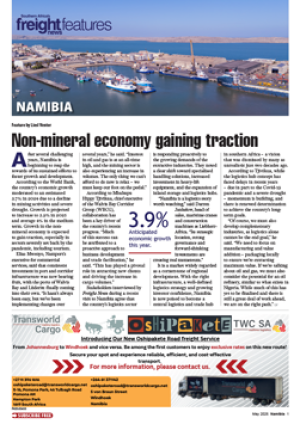With a new CEO at the
company throttle and a
new rail route to Gauteng in the
pipeline, Swaziland Railway is
in a state of positive transition.
While Swaziland’s economy
languishes in comparison to the
performance of other regional
countries, as long as southern
Africa’s economic fortunes remain
stable or growing Swaziland
Railway stands to benefit
considerably.
“75% of Swaziland Railway’s
traffic is transit traffic, and
with the Lothair Line this
will increase to 90%,” CEO
Stephenson Ngubane told
FTW.
This means 90% of the rail
company’s profits will come
from goods en route from
other countries and
passing through
Swaziland
to the ports
of Maputo
and Durban
or heading
from those
seaports
to Gauteng, Mpumalanga and
countries as far north as Zambia.
At present, Swaziland Railway
moves about four million tonnes
of freight per year. The line does
not have passenger service.
Scheduled for completion
in 2017, the 174 km line from
Lothair in SA to Swaziland
Railway’s rail head in Sidvokodvo
will make the Gauteng to Maputo
rail trip faster and cheaper for
freight-moving customers and
will probably put a dent in road
freight traffic along the same
route. SA shippers are expected
to constitute the bulk of future
customers.
“Most of the new business will
come from transit traffic from
South Africa,” said Ngubane.
After serving well for more
than a year as acting CEO,
Ngubane’s appointment as head
of the company in
July 2013 did not
come as a surprise
but was nonetheless
welcome news locally
and amongst the
southern African
railway fraternity.
Ngubane had been
with the railway
since 1986, acquiring
experience in a
number of departments over
subsequent years and earning
the reputation as a well-rounded
railway man.
His agenda includes connecting
the country’s sugar mills to the
rail system, which will cut down
on transport costs for Swaziland’s
top export earner, bulk sugar.
Swazi customers should not be
discounted in light of the assured
profits to be had from transit rail
traffic. Last year, company profits
rose 40% due to the transport of
a local product, iron ore shavings
recovered from a closed mine in
Western Swaziland and moved to
Maputo. Swazi coal railed north
for use in Mpumalanga is another
profitable commodity for the
company.
However, real profit will come
from transit traffic, and Ngubane
feels it is in Swaziland’s interest
to have a connected and vibrant
regional rail system – the better
to funnel freight through the
company’s lines.
In agreement with his fellow
CEOs of southern Africa’s rail
companies, Ngubane said, “We
want to integrate all rail services
and expand the rail system. The
regional rail systems will be made
compatible so goods will move
from one point to anywhere in the
region without interruption.”
INSERT & CAPTION
Most of the new business
will come from transit
traffic from South Africa.
– Stephenson Ngubane

